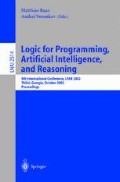Abstract
We present a definition of a Fuzzy Prolog Language that models interval-valued Fuzzy Logic, and subsumes former approaches because it uses a truth value representation based on a union of intervals of real numbers and it is defined using general operators that can model different logics. We give the declarative and procedural semantics for Fuzzy Logic programs. In addition, we present the implementation of an interpreter for this language conceived using R. We have incorporated uncertainty into a Prolog system in a simple way thanks to this constraints system. The implementation is based on a syntactic expansion of the source code during the Prolog compilation.
Access this chapter
Tax calculation will be finalised at checkout
Purchases are for personal use only
Preview
Unable to display preview. Download preview PDF.
References
J. F. Baldwin, T.P. Martin, and B.W. Pilsworth. Fril: Fuzzy and Evidential Reasoning in Artificial Intelligence. John Wiley & Sons, 1995.
Stefano Bistarelli, Ugo Montanari, and Francesca Rossi. Semiring-based constraint logic programming: syntax and semantics. In ACM TOPLAS, volume 23, pages 1–29, 2001.
D. Cabeza and M. Hermenegildo. A New Module System for Prolog. In International Conference on Computational Logic, CL2000, number 1861 in LNAI, pages 131–148. Springer-Verlag, July 2000.
D. Dubois and H. Prade. A review of fuzzy set aggregation connectives. Information Sciences, 36:85–121, 1985.
Mitsuru Ishizuka and Naoki Kanai. Prolog-ELF incorporating fuzzy logic. In IJCAI 9, volume 2, pages 701–703, 1985.
J. Jaffar and J.-L. Lassez. Constraint Logic Programming. In ACM Symp. Principles of Programming Languages, pages 111–119. ACM, 1987.
J. Jaffar, S. Michaylov, P.J. Stuckey, and R.H.C. Yap. The clp(r) language and system. ACM Transactions on Programming Languages and Systems, 14(3):339–395, 1992.
Frank Klawonn and Rudolf Kruse. A Łukasiewicz logic based Prolog. Mathware & Soft Computing, 1(1):5–29, 1994.
E.P. Klement, R. Mesiar, and E. Pap. Triangular norms. Kluwer Academic Publishers.
G. J. Klir and B. Yuan. Fuzzy Sets and Fuzzy Logic. Prentice Hall, 1995.
R.C.T. Lee. Fuzzy logic and the resolution principle. Journal of the Association for Computing Machinery, 19(1):119–129, 1972.
Deyi Li and Dongbo Liu. A Fuzzy Prolog Database System. John Wiley & Sons, New York, 1990.
H. T. Nguyen and E. A. Walker. A First Course in Fuzzy Logic. Chapman & Hall/Crc, Boca Raton, 2000.
A. Pradera. A contribution to the study of information aggregation in a fuzzy environment. PhD thesis, Technical University of Madrid, 1999.
Z. Shen, L. Ding, and M. Mukaidono. Fuzzy resolution principle. In Proc. of 18th International Symposium on Multiple-valued Logic, volume 5, 1989.
Ehud Y. Shapiro. Logic programs with uncertainties: A tool for implementing rule-based systems. In Proceedings of the 8th International Joint Conference on Artificial Intelligence, pages 529–532, Karlsruhe, West Germany, August 1983.
L. Zadeh. Fuzzy sets as a basis for a theory of possibility. Fuzzy sets and systems, 1(1):3–28, 1978.
Author information
Authors and Affiliations
Editor information
Editors and Affiliations
Rights and permissions
Copyright information
© 2002 Springer-Verlag Berlin Heidelberg
About this paper
Cite this paper
Vaucheret, C., Guadarrama, S., Muñoz, S. (2002). Fuzzy Prolog: A Simple General Implementation Using (R). In: Baaz, M., Voronkov, A. (eds) Logic for Programming, Artificial Intelligence, and Reasoning. LPAR 2002. Lecture Notes in Computer Science(), vol 2514. Springer, Berlin, Heidelberg. https://doi.org/10.1007/3-540-36078-6_30
Download citation
DOI: https://doi.org/10.1007/3-540-36078-6_30
Published:
Publisher Name: Springer, Berlin, Heidelberg
Print ISBN: 978-3-540-00010-5
Online ISBN: 978-3-540-36078-0
eBook Packages: Springer Book Archive

